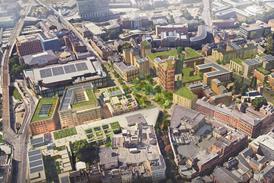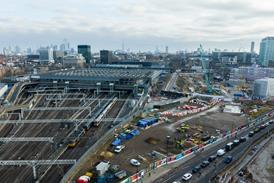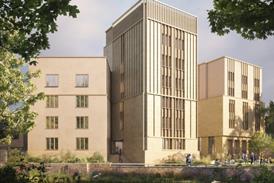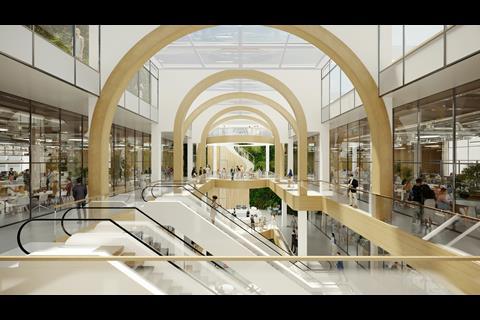Store had been seen as the flagship retail offer at Birmingham’s Grand Central shopping centre
Birmingham council has unanimously approved Make’s plans to convert a vacant John Lewis store above New Street Station into offices.
The building, which will be renamed “Drum”, will be transformed into 200,000sq ft of office space as part of developer Hammerson’s strategy to diversify its Birmingham Estate.
The four-storey John Lewis store only opened in 2015, following the £750m redevelopment of New Street Station overseen by Alejandro Zaera-Polo & Maider Llaguno Architecture.
But the retailer pulled the plug on the branch in 2020, along with seven other outlets described as “financially challenged”, and it never reopened after the first pandemic lockdown. It had been the flagship business at the Grand Central shopping centre, which is owned by Hammerson.
Internal changes will see the former department store’s atrium extended throughout all of its four floors, to include a “a sweeping, open, communal entrance that widens as it rises”.
There will also be a rooftop garden lounge and green walls on each level, while the ground floor for the department store will be repurposed to deliver a restaurant, bar and food market.
> Also read: Make works up plans for Birmingham’s vacant John Lewis store
Hammerson says the redevelopment will create space for 2,000 workers at “the best-connected office in Birmingham”.
The developer’s chief development and asset repositioning officer Harry Badham said the council’s decision was a “significant boost to Birmingham’s reputation as a city for business, one that is progressive, dynamic and setting the benchmark for others to follow across the UK”.
Make founder Ken Shuttleworth has said the plans followed broader work at the practice exploring the UK’s changing retail landscape.
“We’ve been creatively considering how we rethink big box retail within city centres, to ensure we can enliven these key spaces and draw people back into the workplace by prioritising wellbeing and dynamism,” he said.
“We’ve applied this here so the design for Drum goes beyond a traditional workspace in every sense.”
The practice said its designs centred around “innovatively reusing” the John Lewis retail structure, sustainably retaining as much of it as possible and embedding health, wellbeing, and social amenity into the core of the space.
It said refurbishing the unit rather than developing a new building would save approximately 14,000 tonnes of CO2.
Work is expected to begin later this year for completion in 2025.



















No comments yet